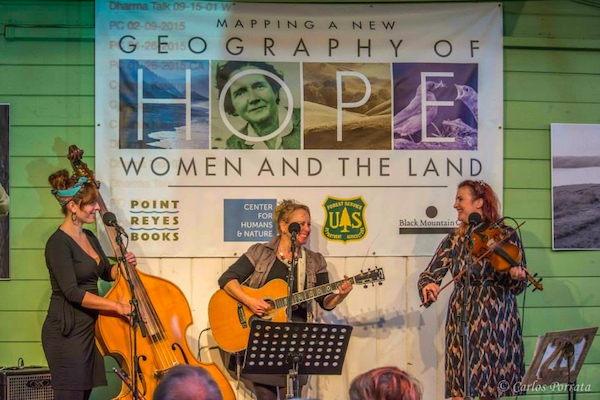“Something will have gone out of us as a people if we ever let the remaining wilderness be destroyed,” Wallace Stegner wrote in 1969,
“if we permit the last virgin forests to be turned into comic books and plastic cigarette cases; if we drive the few remaining members of the wild species into zoos or to extinction; if we pollute the last clear air and dirty the last clean streams and push our paved roads through the last of the silence…”
The wilderness, he said “can be a means of reassuring ourselves of our sanity as creatures, a part of the geography of hope.”
It is from this quote that the Geography of Hope Conference takes its name. This exceptional biennial literary festival is held every other year in the northern California coastal village of Point Reyes Station, California. It is a gathering featuring writers, artists and activists who use their craft to convey the urgency of environmental issues facing the world today.
The 2015 conference – entitled Women and the Land — included three full days of readings and presentations, many held in a local hay barn. Authors Robin Wall Kimmerer and Kathleen Dean Moore co-chaired the 2015 gathering. Moore described the project as challenging but urgent.
“Facing down the forces that would irredeemably disrupt the life-sustaining systems of the world will take the greatest exercise of the human heart and mind the world has ever seen.”
The conference theme presents the question of whether women have a special relationship with the natural world, biological or cultural. Numerous voices were heard on this subject, each with a different point of voice.
Susan Griffin is the author of the book, “Women and Nature, the Roaring Inside Her,” a seminal work of eco-feminism that explores the identification of women with the earth—both as sustenance for humanity and as victims of male aggression and rage. This was her current take on the question of women’s special-relationship with the earth:
“I don’t think it is biological. There are plenty of men who do connect with land. But in general men often think of themselves as above the earth so looking down on it, whether appreciating it or looking at it as expendable, but not of it. Women tend to think of ourselves as of the earth.”
Writer Ann Pancake, author of the novel, “Strange as This Weather Has Been”, about a family in Appalachia devastated by mining, describes the relationship between women and the land in this way:
“In general, across the country women are coming into their own in speaking for the land. Appalachia has a really long history of being defeated. There are people who have been fighting a really long time against environmental devastation. Here in the Pacific Northwest, they don’t have that same history of unrelenting defeat. A large proportion of the activists in Appalachia are middle-aged women. Women more than men seem to feel they can fight it.”
The next Geography of Hope Conference is to be held in 2017, but you need not wait until them to get involved. Visit the Facebook page of the community organization, facebook.com/pages/Geography-of-Hope-Conference, for ideas on current projects and ways to engage. You can also get an idea of the charm and power of this conference by watching videos of past conferences such as those at Point Reyes Books Youtube Channel.
Geography Of Hope Conference Website
Living in France and Northern California, Women Of Green contributing writer Teo Spengler is an attorney, novelist and writer, deeply committed to the environmental movement. Spengler holds a Master of Arts in creative writing from San Francisco State University and a Juris Doctor from UC Berkeley. She is currently a candidate for a Master of Fine Arts in fiction. She writes for Demand Media and EHow in the areas of legal advise, travel, exploring nature, and gardening.
